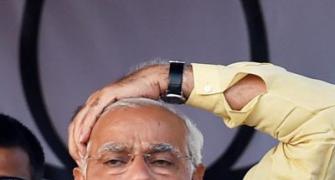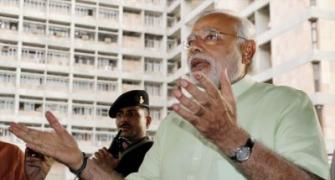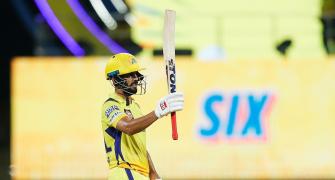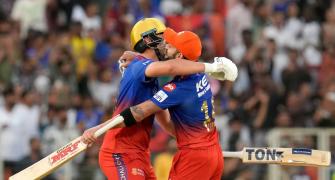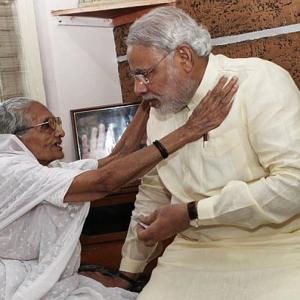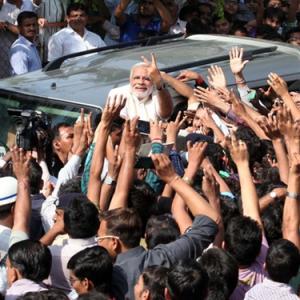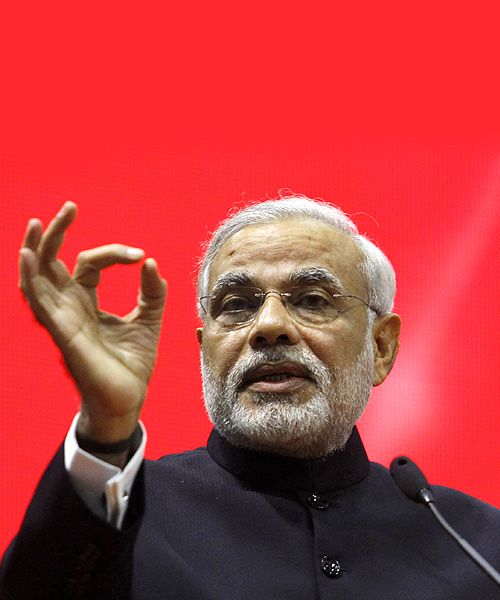 The spread of Modism is in reality the spread of personality cult and not political ideology, says Vidyut Joshi.
The spread of Modism is in reality the spread of personality cult and not political ideology, says Vidyut Joshi.
Narendra Modi is a unique phenomenon in Indian politics. You cannot compare him with A B Vajpayee. At the most he can be compared with Indira Gandhi. Both have almost similar modus operandi -- autocratic, individualistic, revengeful, analytical, dynamic, charismatic, organisation breakers and individual loyalty builders.
But Modi goes a step ahead of Indira Gandhi in the sense that Indira had an ideology, where as Modi has only one consideration -- power, power and more power.
Modi's post-2000 political career can be divided into four phases. 1. Hindu Hriday Samrat phase. 2. Development phase. 3. Sadbhavana phase and 4. Multiple choice phase.
Modi came to power in Gujarat in 2001 by replacing Keshubhai Patel. This was not a simple power shift between two individuals. This was a caste power shift. Keshubhai was a Patel (Patidar), a community that forms 13 percent of Gujarat's population. If the Bharatiya Janata Party wanted to penetrate deep it had to go to the Socially and Economically Backward Classes who formed 49 percent in population. This was a deliberate strategy of the BJP for a power shift, as the Patel hegemony had started eroding the BJP's power base in Gujarat.
So to the Hindutva model was added the OBC model to make it acceptable to a majority of Gujarati people. Thus the BJP experiment in Gujarat, to be replicated in India later on, was not only a Hindutva model, but it was a mixture of religion, caste and development.
Modi was not that powerful when the change of guard took place in 2001. Post the Godhra riots in 2002, Modi gave certain feelers that identified him as Hindu Hriday Samrat. During the 2002 assembly election he deliberately created this image by abusing then Pakistan president as 'Miya Musharraf' or by raising the Pakistan issue, even though foreign policy is not the domain of a chief minister.
He avoided discussion on the post-Godhra issue in public or never made a statement on this to the media. The post-riot polarisation of Hindus was converted into BJP votes in the 2002 elections. After this election, Modi started cutting down senior BJP leaders in Gujarat and in no time he established a personal loyalty in the party. This was exactly what Indira Gandhi did during her tenure.
Within two years of being in power, Modi saw that his Hindutva image does not help much, as people wanted development. Modi started the vibrant Gujarat summits and invited investors to Gujarat by offering a one-window clearance system. This was also the phase of coastal area development in Gujarat and privatisation of ports.
Also, by now, some NGOs and leaders of civil society had started criticising Modi’s image. This image did not pay off during the 2004 Lok Sabha election. It was because of this that during 2007 assembly election that Modi deliberately gave up his Hindutva image and adopted a ‘Vikas purush’ image. He talked of the ‘development of five crore Gujaratis'.
This development image was a slightly better organised strategy. By now he had no opponents within the party as well as without the party. He had taken care of his rivals. Keshubhai, Kashiram Rana, Goradhan Zadafia, A K Patel, Suresh Mehta -- were all out of the power circuit. The Congress was in disarray and organisationally broken.
By 2010 people, especially his critics, started criticising Modi's development model by saying that this is not development of five crore Gujaratis, but the development of five billionaires alone. They emphasised that this was a lopsided development where minorities, Dalits, tribals, women and farmers were left out. The human development index report of Gujarat indicated that though Gujarat is ahead in investment it is much behind in human development indicators.
Then came the 2012 assembly election, when Modi adopted his 'Sadbhavana' (goodwill) stance. He said that he is not only for a few wealthy people, but all Gujaratis are equal before him. In order to prove this he went on sadbhavana dharna (limited hours fast). He organised such dharnas in almost all block level places. People of all types were specially invited to meet Modi during this. Modi won 117 seats out of 182 in that assembly poll.
It was not time to move to the national stage. Modi has indomitable political aspiration (again like Indira). He knew that national politics was more complex than Gujarat. He was being opposed from within the party and also without.
Shrewd political strategist that he is, he could win the battle with some scuffles. He also knew that his Gujarat strategy of sadbhavana may not work at the all-India level, as the situation is much more complex and more diverse. He adopted a multi-choice model including development, his lower caste, Hindu nationalism, opposition to hereditary rule of the Gandhi family, opposition to corruption and price rise and chaiwala beginnings.
In Uttar Pradesh and Bihar, he emphasised on caste and Hindutva. In urban areas and among youth, he emphasised corruption and price rise issues. In Mumbai and other places he played the chaiwala game. He was trying to feel the pulse of the audience at every meeting and moulding his speeches based on popular response. He adopted different stances depending upon the type of people in particular area.
Modi does not have an ideology. Power is the only consideration in his all political thinking and actions. He may change his stance in the next election. This has created a personality cult. Different people like Modi for different reasons. Some pick up his Hindutva sentences, where as some like his chai pe charcha. Some like his anti-Gandhi family attacking style and some like him because he belongs to OBC section of society.
The spread of Modism is in reality spread of a personality cult and not a political ideology.

